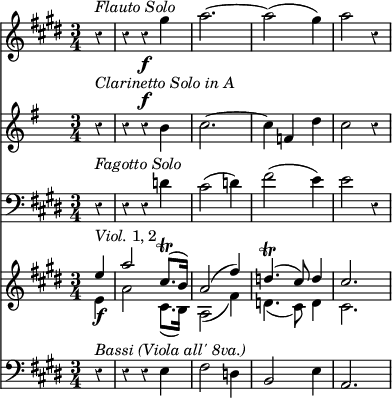Handel, 'Sharp violins proclaim.' (Ode for St. Cecilia's Day.)
![{ \override Score.Rest #'style = #'classical
\time 4/4
<< { \clef treble \key a \major \relative c''
{ r4^\markup { \italic Viol. 1, 2 } r8 e cis16.\trill([ b32 cis8)] b16.\trill([ a32 b8)] |
a16.\trill[ gis32 a8] r e' fis16\trill e fis4 gis8 |
a16[ gis a8\trill] a,[ gis'] fis[ e d cis] | b } }
\new Staff
{ \clef bass \key a \major \relative c'
{ a4^\markup { \italic Bassi } gis a e | fis cis d8 cis b e | a, b cis a d cis b a | e' } }
>>
}](http://upload.wikimedia.org/score/d/s/dshvl4m1c8buhfzh95dv93jc2uyb2t5/dshvl4m1.png)
Ditto (Mozart).
![{ \override Score.Rest #'style = #'classical
\time 4/4
<< { \clef treble \key a \major \relative c''
{ r4^\markup { \italic Viol. 1, 2 } r8 e cis16.\trill([ b32 cis8)] b16.\trill([ a32 b8)] |
a16.\trill[ gis32 a8] r e' fis16\trill e fis4 gis8 |
a16[ gis a8\trill] a,[ gis'] fis[ e d cis] | b } }
\new Staff
{ \clef alto \key a \major \relative c'
{ cis4^\markup { \italic Viola } b e d | cis a( a8) d4 cis16 b | cis8 d e cis d[ e] fis16[ gis a8] | gis } }
\new Staff
{ \clef bass \key a \major \relative c'
{ a4^\markup { \italic Bassi } gis a e | fis cis d8 cis b e | a, b cis a d cis b a | e' } }
>>
}](http://upload.wikimedia.org/score/l/t/ltozoq21bsi66cnjs3r0odqp0urdtgt/ltozoq21.png)
Handel, 'I know that my Redeemer liveth.' (Messiah.)

Ditto (Mozart.)

Bach, 'Ich hatte viel Bekümmerniss.'

Ditto (Franz).

In the first of these extracts nothing is added but a viola part; in the second Mozart has doubled the first violins by the second in the lower octave, and assigned a full harmony to the three solo wind instruments, while in the third Franz has added the string quartett to the solo oboe, and again treated the parts in that polyphonic style which experience has taught him is alone suitable for the fitting interpretation of Bach's ideas.
5. In all the cases hitherto treated, the melody being given as well as the bass, the task of the editor is comparatively easy. It is otherwise however when (as is sometimes found with Handel, and still more frequently with Bach) nothing whatever is given excepting a bass, especially if, as often happens, this bass is not even figured. In the following quotation, for example, taken from Bach's 'Magnificat' ('Quia fecit mini magna'),
![{ \override Score.Rest #'style = #'classical \key a \major \time 4/4 \clef bass \relative c' { r4 a8[ a] a[ gis16 a] a8[ d,] | cis4 cis'8[ cis] cis[ b16 cis] d8[ fis,] | e4 cis'8 e, d4 b'8 d, | cis4 a'16[ gis fis e] d[ cis b a] e'8 e, | a8 } }](http://upload.wikimedia.org/score/c/p/cp0xr1c928kcqqxjwl6y1ai1gwavydt/cp0xr1c9.png)
it is obvious that if nothing but the bass part be played, a mere caricature of the composer's intentions will be the result. Here there are no figures in the score to indicate even the outline of the harmony. The difficulties presented by such passages as these have been overcome in the most masterly manner by Robert Franz, who fills up the score thus—

